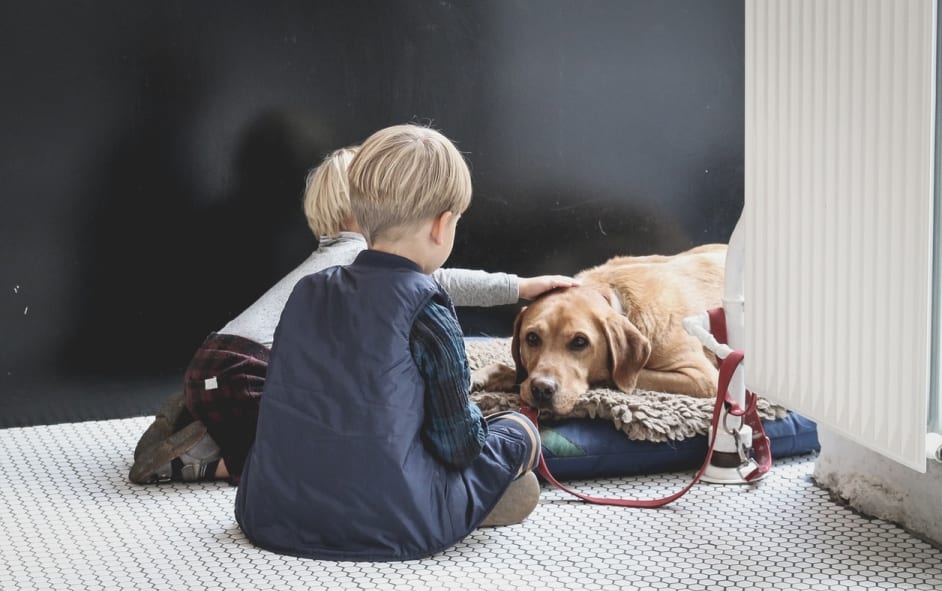Pyometra in dogs
By Hana Crawford
octobre 07, 2021 - 1 min read
What is pyometra?
One of the most common reproductive emergency procedures seen by veterinarians is called pyometra.
The meaning of the word ‘pyometra’ stems from Latin where ‘pyo’ means pus and ‘metra’ means uterus (Hagman, 2018) (the uterus is also known as the womb). Pus is a thick accumulation of fluid that forms when the body fights off bacterial infections (Kumar and Saxena, 2018). This serious, life-threatening condition is seen in sexually mature, unneutered (intact) female dogs (Fransson and Ragle, 2003; Hagman, 2018). It is more common in intact dogs that have never given birth before (Baithalu et al., 2010) and in dogs over four years (Smith, 2006) old affecting 1 in 4 dogs (Jitpean et al., 2014). One to four months following oestrus (being in heat), pyometra is typically diagnosed (Smith, 2006). However, due to the wide range of clinical signs and the potential lack of vaginal pus, it is crucial to act fast and seek immediate veterinary care as animals can deteriorate rapidly and early intervention increases the chances of survival (Hagman, 2018). You can contact us at Veteris, where we are a dedicated 24/7 hospital able to offer out-of-hours emergency consultations should you suspect your pet shows signs of pyometra.
What are the clinical signs and symptoms of pyometra?
A range of clinical signs can appear and may not always be apparent early on due to the slow nature of disease progression.
- A recent season (PDSA, n.d)
- Lack of appetite (Abraham, n.d.)
- Frequent urinating and drinking (Fransson and Ragle, 2003)
- Depression (Smith, 2006)
- Inactivity (Smith, 2006)
- Panting (PDSA, n.d.)
- Swollen abdomen (Smith, 2006)
- Diarrhoea (Abraham, n.d.)
- Vomiting (Fransson and Ragle, 2003)
- Cream/brown/red pus (resembling tomato soup) leaking from the vulva(Fransson and Ragle, 2003; Hagman, 2018; Smith, 2006)
- Regular cleaning of her genitalia
- Grey gums (Abraham, n.d.)
- Collapsing (PDSA, n.d.)
"A very unwell intact female dog with vaginal discharge, frequently drinking and urinating that has not been spayed is a prime candidate for having pyometra"
What causes pyometra?
Pyometra is the outcome of hormonal, bacterial and structural changes in the uterus (Hagman, 2018). When a dog is in heat, the cervix is open, but after the heat cycle, the cervix begins to close, returning to a normal state; this is controlled by a hormone called progesterone (Fransson and Ragle, 2003; Hagman, 2018; Smith, 2006). However, due to this hormonal influence, progesterone can respond inappropriately, and the environment in the uterus becomes ideal for bacteria. One of the most common bacteria resulting in pyometra is Escherichia coli (E. coli) (Fransson, 2003), a microorganism found in the environment or naturally in the body of your pets (Memon, 2013). Bacteria can migrate externally through the vulva to the uterus or through the bloodstream from an infected area elsewhere in the body (Abraham, n.d.; Fransson and Ragle, 2003). However, as a range of microorganisms can cause pyometra, your vet can submit microbiological testing to establish the cause (Hagman, 2018).
Furthermore, when an intact female has repetitive and prolonged exposure to progesterone from her heat cycle, glands in the uterus can increase in size resulting in cysts; this is known as cystic endometrial hyperplasia (CEH) (Crane, 2014), which can lead to pyometra. Although CEH has been identified as a cause of pyometra, it will not necessarily always lead to pyometra (Fransson and Ragle, 2003; Hagman, 2018)
Moreover, drug administration containing the hormones progesterone or oestrogen can predispose animals (Hagman, 2018), especially younger dogs, to pyometra, but this cause is identified less frequently. If you are concerned about a drug treatment your pet is currently taking, please contact your vet.
The structural condition of the cervix is a major factor in the severity of the disease. Approximately 60% of suspected dogs can suffer from sepsis (Hagman, 2018; Smith, 2006)as the uterus can rupture. Other complications include kidney failure, pus leaking into the abdomen ((Kumar and Saxena, 2018) and death. These complications are why acting fast and receiving surgical treatment can save the life of your pet.

What is the difference between an open and closed cervix pyometra?
Pyometra is categorised based on the status of the cervix, open or closed (Fransson, 2003).
An open cervix is a relaxed cervix. Pus will leak from the vulva (Smith, 2006); it can be foul-smelling and appear as cream, brown or red (Baithalu et al., 2010.). It will be identifiable as your pet will leave fluid sporadically where they lay on bedding or their hair or skin under the tail; this is a crucial sign making the diagnosis of open pyometra easier.
A closed cervix is a more severe condition. Pus remains trapped inside the uterus; the uterus enlarges, resulting in abdominal swelling (Abraham, n.d.). The back legs will weaken as pus is heavy, and your pet will appear weak. Some cases have resulted in up to 2kg of pus in the uterus (Blue Cross, 2019). Closed pyometra is fatal and urgent intervention is required (Smith, 2006).

How will the vet diagnose pyometra?
A very unwell intact female dog with vaginal discharge, frequently drinking and urinating that has not been spayed is a prime candidate for having pyometra (Hagman, 2018; Jitpean et al., 2014).
The vet will run various tests to establish a diagnosis which includes
- A Complete Blood Count to assess the standard of cells that aid immune response and proteins that help the body to function (Hagman, 2018; Memon, 2013)
- A Urine Specific Gravity test which determines the quality of urine in the kidneys (Memon, 2013)
- An ultrasound to determine what is happening internally (Hagman, 2018)
- Vaginoscopy (Hagman, 2018)


My dog has been spayed; can she still get pyometra?
A very unwell intact female dog with vaginal discharge, frequently drinking and urinating that has not been spayed is a prime candidate for having pyometra (Hagman, 2018; Jitpean et al., 2014).The vet will run various tests to establish a diagnosis which includesA Complete Blood Count to assess the standard of cells that aid immune response and proteins that help the body to function (Hagman, 2018; Memon, 2013)A Urine Specific Gravity test which determines the quality of urine in the kidneys (Memon, 2013)An ultrasound to determine what is happening internally (Hagman, 2018)Vaginoscopy (Hagman, 2018)



Can all dog breeds get pyometra?
All breeds are susceptible to pyometra; however, it has been observed that there is an increased risk in rough-coated Collies, Rottweilers, Cavalier King Charles Spaniels, Golden Retrievers, Miniature Schnauzers, Chow chow, Irish Terrier, Airedale Terrier and Bernese Mountain dogs (Smith, 2006), while some dog breeds have a reduced risk, this includes German Shepherd, Daschunds and Swedish hounds (Kumar and Saxena, 2018).
What are the treatment options for pyometra?
- Ovariohysterectomy (OHE) (spaying) is a surgical procedure that removes the uterus and ovaries(Hagman, 2018; Smith, 2006). The approach differs slightly from a routine spay as the condition, size of the uterus, and the dog’s poor health makes it somewhat more complicated. However, OHE is a preferred method of choice (Hagman, 2018) with minimum risk, and the prognosis is usually good. Antibiotics will be given to protect against further disease (Hagman, 2018; Memon, 2013).
- Surgical draining can be given for an open cervix pyometra to flush the uterus ((Hagman, 2018). This option could be considered if you have a valuable breeding dog under six years old; however, medically managing with this option long term will not be successful as hormonal changes can result in pyometra returning after pregnancy.
- Antibiotics treatment is not effective against the amount of pus in the uterus (Abraham, n.d.), and antibiotics do not cure a pyometra; it can lead to prolonged suffering, severe illness and death.
- Hormone treatment (Hagman, 2018; Smith, 2006)

What is the aftercare for pyometra surgery?
During recovery, your dog will need to be cared for in a calm environment to make sure they do not cause any trauma to the site of the wound or internally. There are medications, antibiotics and pain relief that you will need to give to your dog. Your dog will need a buster collar to prevent them from tampering with its wound, and this must be kept on your dog until your vet tells you it can be removed (“Pyometra (infected womb) in dogs - PDSA,” n.d.).

I have other dogs. Is pyometra contagious?
No, pyometra is an infectious, hormonally driven disease; it is not contagious and cannot be spread to other animals.
References
Abraham, M., n.d. Pyometra in dogs [WWW Document]. The Kennel Club. URL https://www.thekennelclub.org.... (accessed 4.21.21).
Crane, M.B., 2014. Pyometra, in: Small Animal Critical Care Medicine, Second Edition. Elsevier Health Sciences, pp. 667–671. https://doi.org/10.1016/B978-1-4557-0306-7.00126-4
Fransson, Boel., Ragle, Claude., 2003. Canine Pyometra: An Update on Pathogenesis and Treatment [WWW Document]. Compendium on Continuing Education for the Practising Veterinarian -North American Edition. URL https://www.researchgate.net/p... (accessed 4.18.21).
Hagman, R., 2018. Pyometra in Small Animals. https://doi.org/10.1016/j.cvsm.2018.03.001
Jitpean, S., Ström-Holst, B., Emanuelson, U., Höglund, O. v., Pettersson, A., Alneryd-Bull, C., Hagman, R., 2014. Outcome of pyometra in female dogs and predictors of peritonitis and prolonged postoperative hospitalization in surgically treated cases. BMC Veterinary Research 10, 6. https://doi.org/10.1186/1746-6148-10-6
Kumar, A., Saxena, A., 2018. Canine Pyometra: Current Perspectives on Causes and Management – A Review. THE INDIAN JOURNAL OF VETERINARY SCIENCES AND BIOTECHNOLOGY 14. https://doi.org/10.21887/ijvsbt.v14i1.12998
Baithalu, R., Ranjan Maharana, B., Mishra, C., Sarangi, L., Samal, L., 2010 . Canine Pyometra. Veterinary World Vol.3(7): 340-342
Memon, M., 2013. Pyometra in Small Animals - Reproductive System [WWW Document]. MSD manual veterinary manual . URL https://www.msdvetmanual.com/r... (accessed 4.17.21).
PDSA n.d. Pyometra (infected womb) in dogs. URL https://www.pdsa.org.uk/taking... (accessed 4.20.21).
Smith, F.O., 2006. Canine pyometra. Theriogenology 66, 610–612. https://doi.org/10.1016/j.ther...
Continue reading

How Veteris Champions Sustainability in Vet Care
Discover how Veteris promotes sustainability in vet care through practices that reduce environmental impact while delivering excellent pet treatment.
Read article
Why is My Rabbit Shaking?
Learn why your rabbit might be shaking, from stress or temperature changes to illness, and discover when to seek veterinary care for their safety and comfort.
Read article
